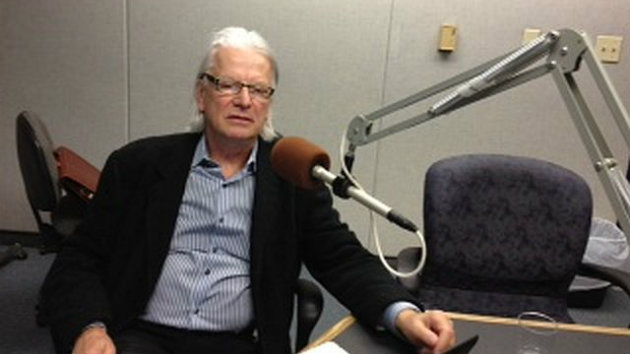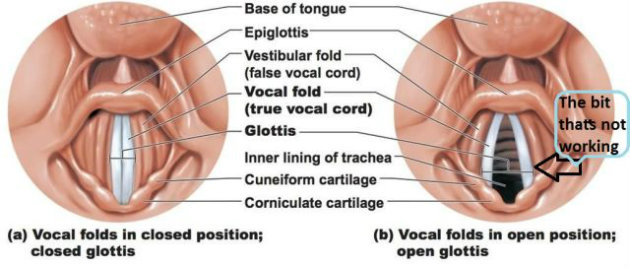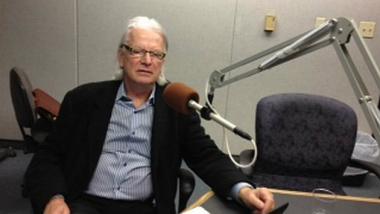
With an instrument down my throat and the Voice Doctor asking for a big "Eeeee..." I couldn't help channeling the Witch Doctor and added a rousing round of variations: "Ooh Eeh Ooh Ah Aah Ting Tang Walla Walla..." We were both amused, he — peering into the computer screen — perhaps not as much as I.
Voice reduced to husky whisper, scope down between oropharynx and hypopharynx, I was still somewhat giddy, singing the immortal masterpiece by Ross Bagdasarian Sr., a.k.a. David Seville, because a long quest, it appears, was at an unexpected end.
It started years ago: I was told or overheard among singers the name "Dr. Izdebski." Rarely, because of the obvious difficulty with Polish, in full: "Krzysztof Izdebski." The name was spoken with confidence in the Voice Doctor, apparently responsible for protecting, curing, healing, and repairing used and abused vocal cords, the instrument that's singers' life and livelihood. My quest: to find and interview him.
The information online is impressive: Chair of the San Francisco-based Pacific Voice and Speech Foundation; vice president of the World Voice Consortium in Portugal; professor at the S.F. Conservatory of Music; associate clinical professor of Head and Neck Surgery, David Geffen School of Medicine at UCLA; scientific adviser of the Brain Plasticity Institute; and adviser to the Bioengineering Department at Santa Clara University. His local practice is at San Francisco Ear Nose Throat Medical Group.
When I finally made contact by email, he was preparing, for the 23rd consecutive year, to chair the Pacific Voice Conference and sixth World Voice Consortium Congress, dedicated to research and technology on caring for the human voice, with emphasis on the artistic voice. It looked impossible to catch him for an exchange — but then luck struck, I became increasingly hoarse and eventually lost almost all my voice. I received referrals Dr. Izdebski. And so, I had him cornered, croaking brief questions, recording his answers:
Why is the voice so neglected, little understood, rarely troublesome — except for singers?
We take voice for granted until it is lost. The reason is that it's sort of automatic. We really do not struggle to make it, until we are confronted with dysphonia, or the voice problem. And then, it's something big: as you're finding out now, just try to go about daily life without using your voice. These days, loss of voice even interferes with communication on so-called smart devices.
Voice is a tool of communication, a tool of labor, a tool for artistic expressions, and a tool for creating advertising or propaganda. Voice sells products. Historically, voice was used to order soldiers to leave the trenches and engage in battle. Voice quality is also associated with gender power.
What are the mechanics of producing voice?
Voice is produced by the smallest double reed wind instrument as air is expelled from the lungs via the two vocal folds or cords found in the neck, in what is popularly called the “voice box.” It is demarcated by the Adam’s apple, prominent in men, but not in women. Each of the tiny double reed (bilateral) instruments is shaped like an ice cream cone. The system can produce up to 10 octaves and its loudness can range from a very faint sound to the sound at the threshold of pain.

Vocal folds are housed inside the larynx. They are tiny, tiny structures, no longer than the length of a nail and not wider than 5 millimeters. They are muscles, covered with mucosa, sort of like a nice piece of red meat wrapped in Saran Wrap. To make sound, there must be space between the muscle and the membrane. In laryngitis, this space is invaded, the resultant voice quality is known to all of us.
The “meat,” the muscle, is under the very complicated central nervous control. There are more than 100 muscles in the body participating in an orderly fashion to sing (even badly) a note. The brain organizes this activity within let's say 100 milliseconds for a declarative voice, but it takes a bit longer with sound that has an emotional (prosodic) tint because to add emotions to the voice the signals must be rerouted to the larynx, the vocal tract and the respiratory systems via the emotional brain.
How do things go wrong with the voice?
Imagine that you are to perform on stage for about an hour, producing a vocal range from around concert A or at the pitch we call fundamental frequency of 440 Hz, or cycles per second.The average vocal fold measures 4 millimeters (tenth of an inch) — which means that at 440 Hz, the vocal fold "travels," or has a trajectory of 4x440 or 1,760 mm per second. So in one minute of singing the vocal fold will travel 1,760x60 seconds or will cover a distance of 105.6 meters. In 60 minutes, the distance will be 6,336 meters (about four miles), so no wonder singing can be fatiguing.
Also, when stressed, we lose ability to control the voice because we lose the lubricant that is needed for the vocal folds to vibrate. So, the artificial saliva was invented to keep people talking even in combat or when suffering from dry-mouth syndrome called xerostomia.
What are some of the mysteries — to the public, at least — about the voice?
Chemically, phonation (speaking or singing) uses CO2, the byproduct of ventilatory air, after it was processed in the lungs to produce oxygen. Making vocal sound is essentially recycling, a remarkably complex process.
Mechanically, the vocal cords are the only muscles in the body that must work in tandem. The larynx is unlike eye muscles, which make the reflexive blink to be bilateral, or the eye closure can be unilateral when we flirt, for example. We cannot move one vocal fold at the time, so there is no inherent vocal flirting. And when one vocal fold behaves differently from the other, the voice suffers.
The human “voice box” undergoes many natural changes through life's odyssey, and endures many insults from within and from the outside. It is not the ideal situation for trained the professional operatic singer or the actor. For some of us, the operatic voice (or other artistic voice) is in a sense an addictive phenomenon. For others it is not, but it is safe to say that all humanity attends to the voice with pleasure no matter the genre of the production. Nearly 7,000 languages have the noun “voice.” Hence, the voice is a sort of “legal drug,” exciting to the sense of hearing and perception and feeding our brain reward centers.
[An amazing example of voice control is Brian Hull impersonating the voices of 21 Disney and Pixar characters in four minutes.]
How do (or how should) singers protect the voice?
Voice production requires a physical effort. It changes our pulmonary ventilatory habits and when produced incorrectly, voice production causes trauma. We call it "phonotrauma." Recovery from it can be very lengthy, a real disaster to a singer. So it is absolutely mandatory for the performer to protect the instrument and not to overuse it under any circumstances. [Writer's note: Tell that to the cast of Wagner operas or of Les Troyens.]
Pacific Voice and Speech Foundation that I chair works with the S.F. Conservatory to educate singers and to prevent vocal injuries and to cure the voices of artists that went “bust.” It is a challenging task, but extremely rewarding. We, the audience, must respect the athletic challenges the professional voice user faces. We also must respect the commitment of the vocal pedagogues and students of voice, who work with such dedication to make the smallest wind instrument the most elegant vocalizer.
Note: With medication, exercises, and great good luck, my voice returned, but I will never take those tiny muscles for granted again. Doctors, experts, and singers agree on basic measures to maintain a healthy voice: hydration, support from abdominal muscles, avoiding abusive behavior (coughing, yelling, prolonged loud talking), warming up the voice, being careful with aspirin products and antihistamines.

